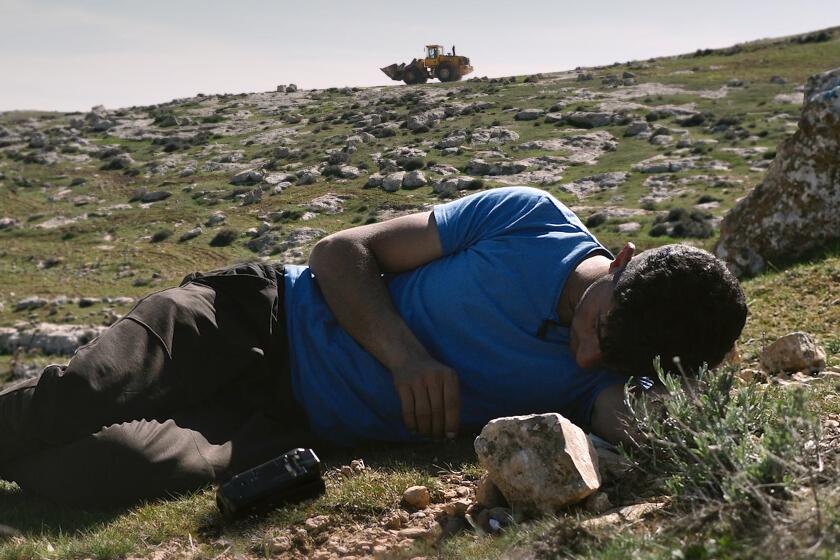An Apocalypse of Kinetic Joy
- Share via
“Imagine you’re feeling a little like Alice, tumbling down the rabbit hole,” someone says in the dazzling and disorienting “The Matrix,” and who has the strength to argue?
A wildly cinematic futuristic thriller that is determined to overpower the imagination, “The Matrix” combines traditional science-fiction premises with spanking new visual technology in a way that almost defies description. Like it or not, this is one movie that words don’t come close to approximating.
Written and directed by the Wachowski brothers, Larry and Andy, “The Matrix” is the unlikely spiritual love child of dark futurist Philip K. Dick and the snap and dazzle of Hong Kong filmmaking, with digital technology serving as the helpful midwife.
Yet because this tale has been on the Wachowskis’ minds for so long--it was written before their 1996 debut film, “Bound”--”The Matrix” never feels patched together. And its story, constructed though it is from familiar elements and pseudo-mystical musings, is nevertheless strong enough to support the film’s rip-roaring visuals.
Thomas Anderson (Keanu Reeves), a software programmer in a world very much like our own who goes by his nighttime hacker moniker of Neo, has heard the Matrix whispered about his whole life, but no one knows what it is. All the beautiful Trinity (Carrie-Anne Moss of TV’s “Dark Justice”) can tell him is that “it’s looking for you,” which is certainly scary but not a great deal of help.
For that Neo has to turn to Trinity’s partner, the legendary Morpheus (Laurence Fishburne), considered the most dangerous man alive by the authorities. What he says is more than frightening: What Neo thinks is the real world is no more than a computer-generated dreamscape, a virtual reality created by the artificial intelligence that really controls things to distract our human minds while our bodies are systematically plundered as an energy source to keep those nefarious machines up and running.
Sometimes those machines take human form as agents, robotic parodies of FBI men, like the chilling Agent Smith (Hugo Weaving of “Proof” and “The Adventures of Priscilla, Queen of the Desert”), who wear security earpieces, sunglasses and white shirts with ties and are terrifyingly close to indestructible.
These Matrix men have a special interest in Neo. There’s a feeling in the air, one that Morpheus and his ragtag colleagues (including “Bound” veteran Joe Pantoliano) are tempted to share, that Neo might be the One, the foretold liberator who has the power to destroy the Matrix and free the human race. But only the Oracle (a fine cameo by Gloria Foster) knows for sure, and everything she says is, well, oracular.
Obviously, there’s a great deal that’s familiar about “The Matrix,” starting with its sturdy themes of alternate realities, the deadly rivalry between men and machines, the resilient power of the human mind and the creeping dangers of conformity. And the film’s fake-Zen dialogue, lines like “Don’t think you are; know you are” and “There’s a difference between knowing the path and walking the path,” isn’t going to win any ovations for originality.
On the other hand, the somber quality of the dialogue suits the apocalyptic quality of “The Matrix” story, and the gravity of the actors, especially the always magisterial Fishburne and the magnetically phlegmatic Reeves, makes the words more bemusing than bothersome.
Helping most of all are the riveting visuals shot by Bill Pope. The Wachowskis do have a taste for the bizarre (witness an electronic bug that turns into a body-piercing insect) but this tendency pays off in bravura moments like a mesmerizing vista of a body farm without end (inspired by the work of comic-book artist Geof Darrow) where humans are relentlessly harvested for energy like so many replaceable Eveready batteries.
Just as exciting are “The Matrix’s” two kinds of action sequences. One strata involves John Woo-type expenditures of massive amounts of ammunition shot in super slow-motion and the other uses both Hong Kong-style stunt work and a technique the press notes refer to as “bullet-time photography” that involved shooting film at the computer-aided equivalent of 12,000 frames per second.
“The Matrix” cast members who were involved in the film’s eye-catching kung fu fight sequences also apparently committed to four months of pre-production work with Hong Kong director and stunt coordinator Yuen Wo Ping, someone who specializes in the technique, known as wire fighting, that gives H.K. films like “Drunken Master,” “Once Upon a Time in China” and “Fist of Legend” their distinctive high-flying look.
Not everything in “The Matrix” makes even minimal sense, but the Wachowski brothers, said to be major fans of comic books and graphic novels, are sure-handed enough to smoothly pull us over the rough spots. When a film is as successful as this one is at hooking into the kinetic joy of adrenalized movie making, quibbling with it feels beside the point.
* MPAA rating: R for sci-fi violence and brief language. Times guidelines: several grotesque moments involving voracious and aggressive oversized insect-like beings, plus a graphic beating.
‘The Matrix’
Keanu Reeves: Neo
Laurence Fishburne: Morpheus
Carrie-Anne Moss: Trinity
Joe Pantoliano: Cypher
Hugo Weaving: Agent Smith
Warner Bros. presents, in association with Village Roadshow Pictures-Groucho II Film Partnership, a Silver Pictures production. Written and directed by the Wachowski brothers. Producer Joel Silver. Executive producers Barrie Osborne, Andrew Mason, Andy Wachowski, Larry Wachowski, Erwin Stoff, Bruce Berman. Cinematographer Bill Pope. Editor Zach Staenberg. Music Don Davis. Costume designer Kym Barrett. Production designer Owen Paterson. Art directors Hugh Bateup, Michelle McGahey. Running time: 2 hours, 19 minutes.
In general release.
More to Read
Only good movies
Get the Indie Focus newsletter, Mark Olsen's weekly guide to the world of cinema.
You may occasionally receive promotional content from the Los Angeles Times.











